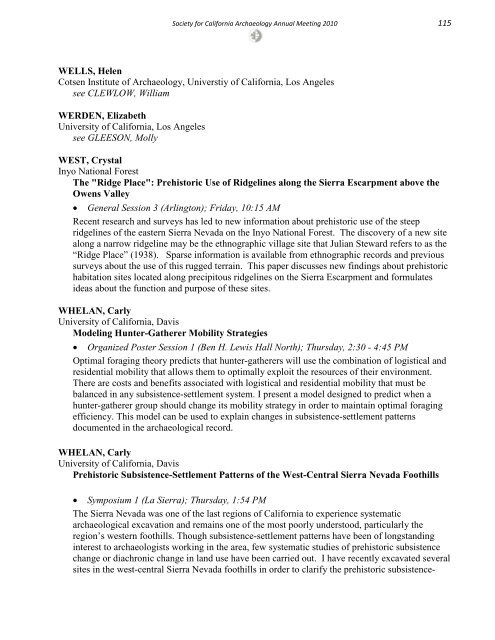Society for California Archaeology 2010 Annual Meeting
Society for California Archaeology 2010 Annual Meeting
Society for California Archaeology 2010 Annual Meeting
Create successful ePaper yourself
Turn your PDF publications into a flip-book with our unique Google optimized e-Paper software.
<strong>Society</strong> <strong>for</strong> Cali<strong>for</strong>nia <strong>Archaeology</strong> <strong>Annual</strong> <strong>Meeting</strong> <strong>2010</strong> 115<br />
WELLS, Helen<br />
Cotsen Institute of <strong>Archaeology</strong>, Universtiy of Cali<strong>for</strong>nia, Los Angeles<br />
see CLEWLOW, William<br />
WERDEN, Elizabeth<br />
University of Cali<strong>for</strong>nia, Los Angeles<br />
see GLEESON, Molly<br />
WEST, Crystal<br />
Inyo National Forest<br />
The "Ridge Place": Prehistoric Use of Ridgelines along the Sierra Escarpment above the<br />
Owens Valley<br />
• General Session 3 (Arlington); Friday, 10:15 AM<br />
Recent research and surveys has led to new in<strong>for</strong>mation about prehistoric use of the steep<br />
ridgelines of the eastern Sierra Nevada on the Inyo National Forest. The discovery of a new site<br />
along a narrow ridgeline may be the ethnographic village site that Julian Steward refers to as the<br />
“Ridge Place” (1938). Sparse in<strong>for</strong>mation is available from ethnographic records and previous<br />
surveys about the use of this rugged terrain. This paper discusses new findings about prehistoric<br />
habitation sites located along precipitous ridgelines on the Sierra Escarpment and <strong>for</strong>mulates<br />
ideas about the function and purpose of these sites.<br />
WHELAN, Carly<br />
University of Cali<strong>for</strong>nia, Davis<br />
Modeling Hunter-Gatherer Mobility Strategies<br />
• Organized Poster Session 1 (Ben H. Lewis Hall North); Thursday, 2:30 - 4:45 PM<br />
Optimal <strong>for</strong>aging theory predicts that hunter-gatherers will use the combination of logistical and<br />
residential mobility that allows them to optimally exploit the resources of their environment.<br />
There are costs and benefits associated with logistical and residential mobility that must be<br />
balanced in any subsistence-settlement system. I present a model designed to predict when a<br />
hunter-gatherer group should change its mobility strategy in order to maintain optimal <strong>for</strong>aging<br />
efficiency. This model can be used to explain changes in subsistence-settlement patterns<br />
documented in the archaeological record.<br />
WHELAN, Carly<br />
University of Cali<strong>for</strong>nia, Davis<br />
Prehistoric Subsistence-Settlement Patterns of the West-Central Sierra Nevada Foothills<br />
• Symposium 1 (La Sierra); Thursday, 1:54 PM<br />
The Sierra Nevada was one of the last regions of Cali<strong>for</strong>nia to experience systematic<br />
archaeological excavation and remains one of the most poorly understood, particularly the<br />
region’s western foothills. Though subsistence-settlement patterns have been of longstanding<br />
interest to archaeologists working in the area, few systematic studies of prehistoric subsistence<br />
change or diachronic change in land use have been carried out. I have recently excavated several<br />
sites in the west-central Sierra Nevada foothills in order to clarify the prehistoric subsistence-

















